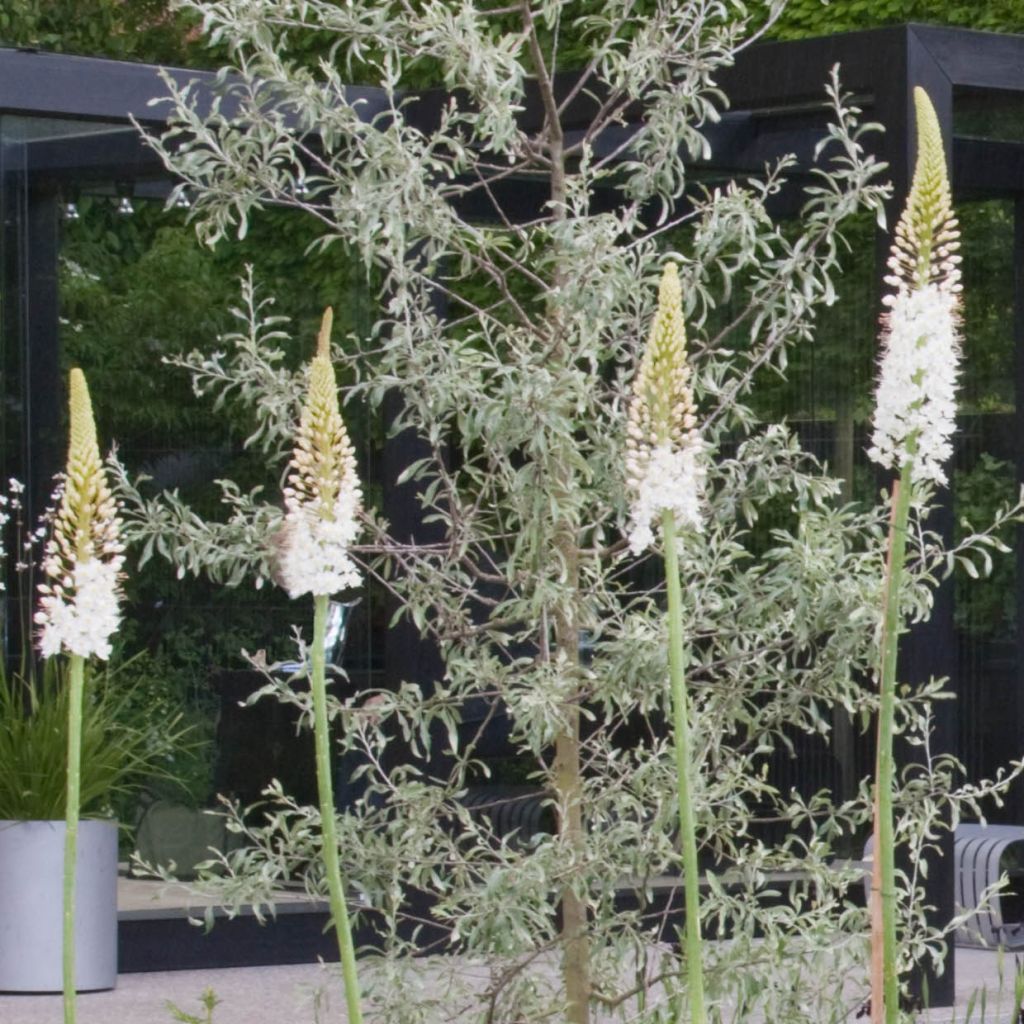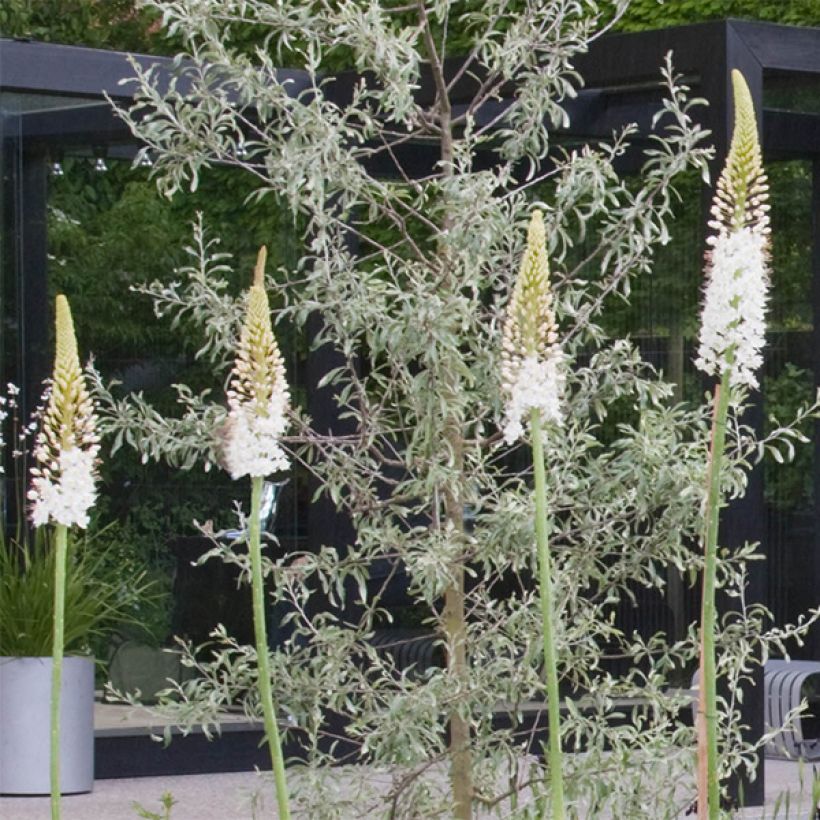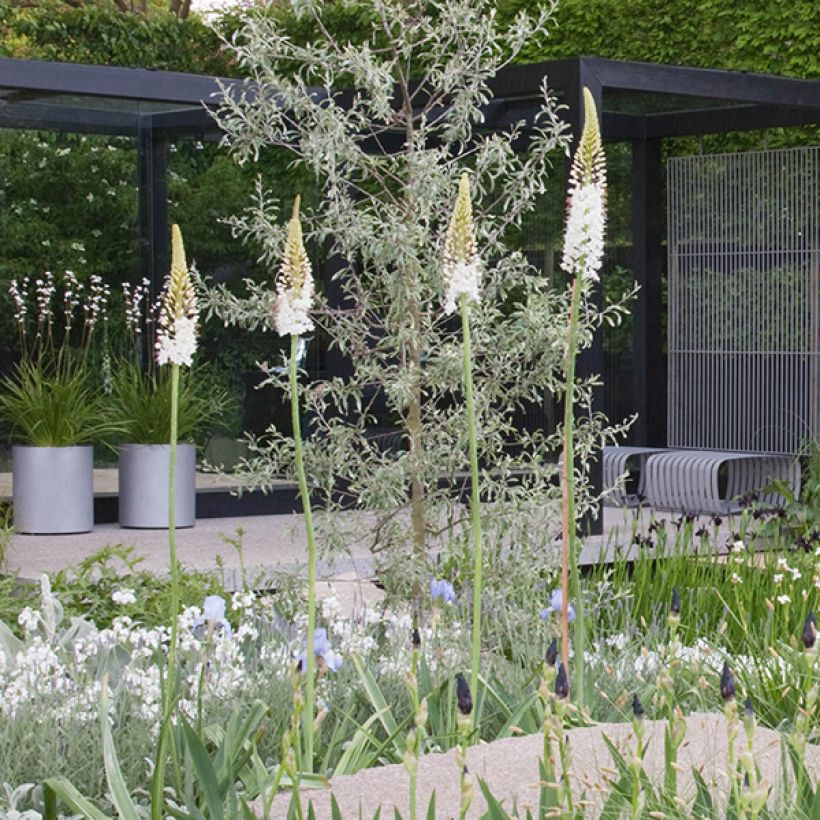

Eremurus White Beauty Favourite - Lis des steppes
Eremurus White Beauty Favourite - Foxtail Lily
Eremurus White Beauty Favourite
Foxtail Lily
This plant carries a 6 months recovery warranty
More information
We guarantee the quality of our plants for a full growing cycle, and will replace at our expense any plant that fails to recover under normal climatic and planting conditions.
From €7.90 for pickup delivery and €6.90 for home delivery
Express home delivery from €8.90.
Does this plant fit my garden?
Set up your Plantfit profile →
Description
Eremurus 'White Beauty Favourite', also known as the Ruiters Hybrid Steppe Lily, is a truly astonishing perennial plant with a tuberous root. In late spring or early summer, it produces enormous spikes that are surprisingly light despite their imposing size. They are covered in hundreds of small ivory-white star-shaped flowers with yellow centres and stamens, emerging from a clump of ribbon-like foliage. Vigorous and spectacular, this highly sculptural plant adapts to all styles of gardens. It thrives in sunny, well-drained soils. It dislikes strong winds and wet soils in winter.
Originating from the cold high plains of Asia, the 'White Beauty Favourite' steppe lily is a majestic plant of hybrid origin that can reach up to 1.25m (4ft) in height. In its native lands, these very hardy plants survive the winter thanks to the protection of a thick blanket of snow. The bulb, formed by large fleshy roots surrounding a bud, resembles an octopus. This tuberous stump produces a clump of luxuriant ribbon-like leaves that can grow up to 80cm (32in) in height. The leaves are deciduous and wither as the first floral spikes emerge in May-June. The star-shaped flowers bloom from bottom to top, allowing the plant to be in flower for several weeks.
The majesty and elegance of Eremurus 'White Beauty Favourite' make it perfect for perennial borders, where other flowers can decorate its bare stem when it is in full bloom. It can be planted in groups, among English roses, or alongside foxgloves, clary sage, meadow grasses, delphiniums, fennel, or toadflax to create an imposing scene with a romantic touch. However, care should be taken to ensure that the planting is not too dense, as this plant does not appreciate root competition. It can also be grown in a large container on a patio or in a small garden, taking care to accompany it with a pretty ground cover that will not smother it, such as aubrieta or creeping bugle.
Eremurus White Beauty Favourite - Foxtail Lily in pictures




Plant habit
Flowering
Foliage
Botanical data
Eremurus
White Beauty Favourite
Asphodelaceae
Foxtail Lily
Cultivar or hybrid
Planting and care
Plant Eremurus 'White Beauty Favourite' during September-October in a sunny location, sheltered from the wind to prevent damage to the flower spikes. Place it in rich, deep, loose, fertile soil that is moist but very well-drained. Well-drained soil improves root development and hardiness. To improve drainage, you can mix coarse sand into the soil at the time of planting. Plant the tubers in autumn at a depth of no more than 7cm (3in) as it needs to be quickly warmed by the sun's rays in spring. Winter moisture is fatal to it. Protect the plant with a thick mulch of fern leaves, pruning waste, or straw, without covering the collar. Young shoots should be protected with a dry mulch. The firmly rooted plant does not require staking, except in regions where the wind is particularly frequent and strong.
Eremurus can be divided and multiplied in autumn, every 3 or 4 years, by carefully separating the tubers. Look at the base of the stump, near the faded flower stem, to identify the presence of 2 buds. They can be separated while retaining some of the tuberous roots; each will produce a flower stem the following year.
Planting period
Intended location
Care
Haven't found what you were looking for?
Hardiness is the lowest winter temperature a plant can endure without suffering serious damage or even dying. However, hardiness is affected by location (a sheltered area, such as a patio), protection (winter cover) and soil type (hardiness is improved by well-drained soil).

Photo Sharing Terms & Conditions
In order to encourage gardeners to interact and share their experiences, Promesse de fleurs offers various media enabling content to be uploaded onto its Site - in particular via the ‘Photo sharing’ module.
The User agrees to refrain from:
- Posting any content that is illegal, prejudicial, insulting, racist, inciteful to hatred, revisionist, contrary to public decency, that infringes on privacy or on the privacy rights of third parties, in particular the publicity rights of persons and goods, intellectual property rights, or the right to privacy.
- Submitting content on behalf of a third party;
- Impersonate the identity of a third party and/or publish any personal information about a third party;
In general, the User undertakes to refrain from any unethical behaviour.
All Content (in particular text, comments, files, images, photos, videos, creative works, etc.), which may be subject to property or intellectual property rights, image or other private rights, shall remain the property of the User, subject to the limited rights granted by the terms of the licence granted by Promesse de fleurs as stated below. Users are at liberty to publish or not to publish such Content on the Site, notably via the ‘Photo Sharing’ facility, and accept that this Content shall be made public and freely accessible, notably on the Internet.
Users further acknowledge, undertake to have ,and guarantee that they hold all necessary rights and permissions to publish such material on the Site, in particular with regard to the legislation in force pertaining to any privacy, property, intellectual property, image, or contractual rights, or rights of any other nature. By publishing such Content on the Site, Users acknowledge accepting full liability as publishers of the Content within the meaning of the law, and grant Promesse de fleurs, free of charge, an inclusive, worldwide licence for the said Content for the entire duration of its publication, including all reproduction, representation, up/downloading, displaying, performing, transmission, and storage rights.
Users also grant permission for their name to be linked to the Content and accept that this link may not always be made available.
By engaging in posting material, Users consent to their Content becoming automatically accessible on the Internet, in particular on other sites and/or blogs and/or web pages of the Promesse de fleurs site, including in particular social pages and the Promesse de fleurs catalogue.
Users may secure the removal of entrusted content free of charge by issuing a simple request via our contact form.


































